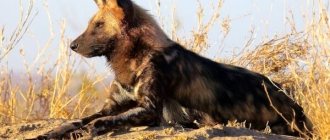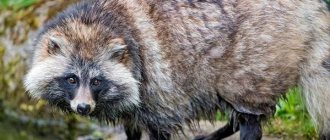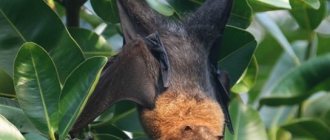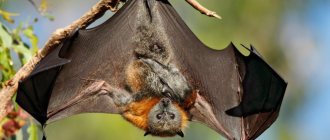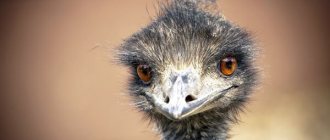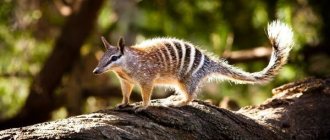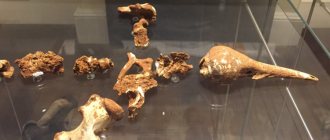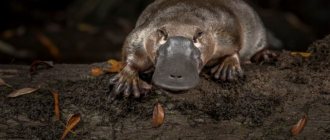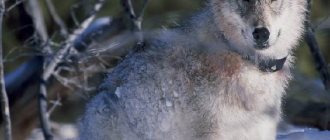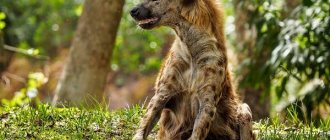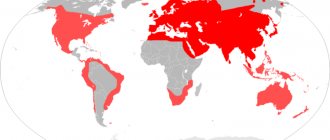- Wild animals
- >>
- Mammals
The dingo is a feral domestic dog native to Australia. The animal differs from all other Australian predators in that its cubs appear in a developed stage, being placental. The Latin name consists of three words meaning dogs, wolves and has a personal name - dingo: Canis lupus dingo.
Origin of the species and description
Photo: Dingo
This mammal from the order of predators belongs to the canine family, but to the genus and species of wolves, standing out as a separate subspecies - dingo. Ancient remains of similar animals were discovered in Vietnam and date back to 4 thousand years BC, in Timor-Leste on the islands of Southeast Asia - 3 thousand years BC. The remains of dingoes were found in Thoress Strait; they are 2.1 thousand years old BC. New Guinea remains of dogs dating back to 2.5-2.3 thousand years BC were recorded at a slightly earlier date. and they are not the ancestors of the New Guinea Singing Dog.
The most ancient skeletal remains of dingoes:
- from the Australian Mandurah Cave in the south-east of Western Australia (3.4 thousand years BC);
- at the settlement of Wumba in New South Wales (3.3 thousand years BC);
- at Mannum on the Murray River in South Australia (3.1 thousand years BC);
- on Mount Burr in South Australia (8.5 thousand years BC).
Genetic studies show that the dingo is a descendant of the gray wolf, but not a descendant of the current species. They share common ancestors, but the dingo's ancestors became extinct at the end of the Late Pleistocene. Dogs and dingoes are members of the same branch - the clade. New Guinea singing dogs and dingoes from south-eastern Australia are genetically closely related.
Interesting fact: These dogs do not bark, but they can howl and growl.
After domesticated dogs arrived on the Australian mainland, they went wild again. The first European settlers became acquainted with these animals in the form in which these predators are found to this day.
Appearance and features
Photo: Wild dog dingo
The animal is of medium size when compared with other dog breeds. They have a length of 50-60 cm (females are slightly smaller), weight 13-19 kg. The wedge-shaped head seems a little large relative to the body, but is elegant. A high skull with a developed occiput, flat and wide between the ears, tapering towards the nose. Black nostrils are open (in light dogs they are liver-colored). The powerful lower jaw is clearly visible. Lips cover teeth. Scissor bite with complete dentition.
Video: Dingo
The eyes are almond-shaped, set slightly askew, medium in size, dark in color. The ears are triangular, stand upright with a rounded tip, are very expressive and are located at the top of the skull. The well-developed, muscular neck is of moderate length, and the head is set high on it. The animal's back is straight and strong, its chest is light. The croup is wide and angular, with sufficient length from hip to hock to act as a spring for jumping, as an effective lever for developing speed. The paws are oval, with fur between the pads.
The tail is well developed and widens to the middle of the length, and then tapers towards the end. Individuals in the northern regions of the continent have fur with an undercoat and coarse outer protective hairs; dogs from the southern regions have no undercoat. The color is reddish, cream with a golden tint, brown, and there are black specimens. There may be a mask of a lighter color on the face, and there is also a lighter shade on the throat, belly and under the tail. Black and brown dingoes may have light-colored spots on their legs, chest, cheeks, and eyebrows. This is a very smart animal, curious but cautious. It is resilient and reacts instantly to stimuli. The dogs are independent by nature, but they know how to behave in a pack.
Interesting fact: Twice a year, dingoes make a voyage to the sea coast. Individuals living in New South Wales also climb mountain paths to New England and other ridges of the Australian Alps twice a year in April and November.
Where do dingoes live?
Photo: Dingo in Australia
This species of wild dog can be found throughout Australia. The northern part is the most densely populated. In the very middle of this area, the habitat of a large tongue descends to the south in the central part of the continent, and also covers the western part in a semicircle. Here dingoes can be found most often, although in other regions this animal is not uncommon. Small isolated groups live in New Guinea and some countries in Southeast Asia:
- Myanmar;
- Thailand;
- Laos;
- Borneo;
- Philippines;
- Malaysia;
- Bangladesh;
- southeast China.
For settlement, dogs prefer eucalyptus forests and semi-deserts. In wooded areas, they make beds and dens under the roots of trees, under dead wood, in dense thickets of bushes or grass, in crevices and rocky caves. Also, dogs often occupy empty animal burrows, which become prey for dingoes. They give preference to places located near rivers and other sources of fresh water. Dingoes often settle near human habitation, where they can easily find food in landfills or by hunting domestic animals.
Fun fact: Australia has the longest fence in the world, called the Dingo Fence. It separates the southeast of the mainland from the rest and is designed to protect agricultural pastures from dog invasion. The height of the mesh fence is 1.8 m. On both sides, a five-meter zone is cleared of vegetation. The supports are wooden posts. Some places have lighting and are powered by solar panels.
The fence was originally erected in 1880 to stop the spread of rabbits, but it was a futile endeavor and by the early twentieth century the structure had collapsed in many places. But then some states decided to restore the fence to prevent wild dogs from attacking sheep. So in 1932, the Queensland government purchased 32 thousand km of mesh to restore the fence. By the forties, individual sections were united into a single chain, and the total length was about 8.6 thousand km. Now the structure exceeds 5.6 thousand km. It costs up to $10 million to maintain it.
Now you know where the dingo lives. Let's see what a wild dog eats.
Habitat
Dingoes prefer forests and grasslands extending to the forest edges. They can be found in deserts, tropical swamps, snow-capped mountain peaks, plains and coastal scrub. Australian wild dogs make dens in caves, rabbit holes or hollow logs, all in close proximity to water .
Photo: David Clode
Most Asian populations live near villages, where people provide them with food and shelter in exchange for protecting their homes.
- Habitat: tropical
- Terrestrial biomes: forest, suburb, desert, plains, mountains, coastal
What does a dingo eat?
Photo: Australian Dingo
The dog, having arrived in Australia, did not encounter any other serious predators except marsupial wolves and the Tasmanian devil, and therefore easily settled throughout the territory and hunted animals of suitable size. They completely ousted their competitors from the continent.
Just over half of the dog's diet consists of small mammals such as rats, rabbits, possums and wallabies, and it preys on larger kangaroos and wombats. About 40% of the menu consists of birds, reptiles, amphibians, fish, crustaceans, carrion, and insects.
Kangaroos are faster and larger than dingoes, but a pack of dogs can chase a marsupial mammal for hours, replacing each other at a distance and taking advantage of respites. The kangaroo gets tired of prolonged pursuit and cannot stand it. Dingoes in a flock always take turns during meals. The biggest and most dominant members get the best cuts.
Interesting fact: A flock of dingoes of 12-14 individuals, attacking sheep, can destroy up to 20 heads at once without eating them. The share of livestock in the diet is about four percent and the main part is poultry: chickens, ducks, geese, turkeys.
Dingoes also hunt emus, which are many times taller than them. During the jump, the dog tries to grab the bird's neck, as close to the head as possible. The emu, noticing the danger, makes high jumps and tries to push the predator away with its foot. Dingoes are not always tough on such large and agile prey, and therefore the dog does not pose a serious threat to this bird. In the countries of Indochina, the dingo menu contains more human food waste: rice, fruits, fish, chicken. Sometimes they hunt rats, lizards, and snakes.
Role in the ecosystem
Dingoes are the main carnivorous mammals of Australia. They compete with foxes and wild cats for small animals, but dingoes are more successful at catching large prey during droughts than foxes and cats. For this reason, dingo populations remain large and are believed to be responsible for the demise of numerous medium-sized Australian mammals. However, some researchers suggest that wild dogs, on the contrary, help maintain populations of small Australian mammals. Dingoes are also valued for their help in controlling populations of European rabbits and feral pigs, which are pests throughout Australia.
Features of character and lifestyle
Photo: Dingo dog
The active phase in the life of a dingo occurs during twilight hours. During the day, during the hot season, these dogs rest in thickets of grass or bushes. In the evening, when they go hunting, they stay in a flock. Small animals become prey for single animals.
A dingo does not always win a one-on-one fight with a kangaroo. Especially if he does not run away, but, having taken a defensive position, tries to scare the enemy and fight back with his front paws and claws. And the dogs themselves do not go into such a head-on fight, realistically assessing their strength. The pack hunts by stalking, attacking the enemy, which is larger than dogs, from different sides.
Interesting fact: Larger and older animals go hunting away from the den. The territory near the home remains for young, still inexperienced individuals.
In the heat of excitement, dogs can run up to 20 km a day, reaching a speed of 55 km per hour. Dingoes are very dexterous, flexible animals, they are smart and smart. This is why it was so difficult for farmers to fight these predators. They avoid traps and are very wary of various types of bait.
Australian sheep typically graze without human intervention and are guarded only by herding dogs. Domestic dogs, even if they are larger in size than dingoes, cannot always resist a flock of dingoes, which can tear apart both the furry guard and cut the sheep he protects.
Interesting fact: Dingo, cut off from its fellow tribesmen by domestic dogs, can fight fiercely, despite the obvious loss in strength, but at the same time it often shows cunning. A wild dog can pretend to be dead and, seizing the moment, elude its pursuers.
You can distinguish a dingo cross from a real, purebred dingo by its ability to bark. Also, no matter how aggressive the feral ancestors of domestic dogs are, they do not attack humans, which cannot be said about those animals that were crossed with other breeds.
Dingo puppies are easy to tame, but their independent nature emerges as they age. This is especially noticeable during the mating season. In any case, this dog recognizes only one owner and if it loses it, it dies or goes into the wild.
Due to the danger of crossing these dogs with other domestic breeds and the manifestation of aggression in the offspring in such mixed litters, it is prohibited to own dingoes in Australia. In other countries of Southeast Asia, domesticated dogs are quite independent, live near human habitation and almost never hunt, eating what they can find or what the owner gives.
Interesting fact: Australian Aborigines often adopted dingo puppies. They were taught to hunt and search for healthy food roots. After the death of the animal, it was buried with honors.
During dry summers, dingo flocks disperse. Also, these animals have adapted to droughts, being content only with the liquid contained in their food. For puppies that are no longer feeding on milk, dogs regurgitate water.
Cubs development
Photo: www.australiandoglover.com
The dingo is a placental mammal , meaning it gives birth to live young that are fed milk through the mammary glands. The young are raised in hollow logs, rock shelters, old rabbit holes or wombat dens. Both parents are involved in the process of nurturing the offspring.
Puppies first leave the birth den at three weeks of age. Puppies are weaned after approximately two months, after which the young remain with their parents for up to 12 months. are accompanied by adults on longer trips . The transition from milk to solids begins at 9 weeks and is usually completed at 12 weeks of age.
Dingo pups are fully grown by seven months, and by 10 months they leave the pack as the next mating season begins.
Social structure and reproduction
Photo: Dingo puppies
Dingoes often form flocks of 10-14 individuals. Their structure and the behavior of individuals within society can be compared to a wolf pack, where there is a strict hierarchy, and large and strong males are given the main role of leader. The pack has its own territory for hunting and can defend its borders by fighting with another group of dingoes. Young people often hunt alone, although they can gather in a group for large prey.
These animals are monogamous. They reproduce once annually. In a pack, only the dominant pair raises puppies; the rest of the puppies are destroyed by the female from the leading pair. Other community members help in the care and education of the younger generation. Large, adult animals become the leading pair no earlier than the third year. The mating season in Australia takes place in March and April, and in Asian regions in August and September.
Dingoes make secret shelters for whelping and nursing their offspring in burrows, caves, gullies and under tree roots. Pregnancy lasts 61-68 days. On average, 5-6 puppies are born, but there are litters of up to ten individuals. They are covered with fur, but are not sighted in the first days of their life. If the bitch senses some kind of danger, she moves the entire litter to another den.
After three weeks, the puppies emerge from the den. At two months they stop drinking their mother's milk. Not only the parents feed the offspring, but also members of the pack lower in the hierarchy, regurgitating the meat eaten after the hunt to the puppies. After eight weeks, the babies join the pack and begin hunting at the age of four months.
During their two years of life, young dogs spend time with their mother, gaining hunting experience and life skills. Puberty occurs at approximately 2-3 years. The average lifespan of wild animals is about ten years.
Communication
Photo: Russell Mcphedran
Dingoes rarely bark, and purebred individuals do not know how to do this at all. They tend to growl and howl like a wolf, especially at night, to attract pack members or scare away potential intruders. There are other forms of communication used to mark territorial boundaries:
- friction with aromatic glands;
- defecation and urination on objects such as tree bark and grass tussocks.
Natural enemies of dingoes
Photo: Dingo
Among the animal world of Australia, dingoes have few enemies, which is why this type of feral dog so easily populated the entire continent. They were not competed by local marsupial wolves and devils, which used to live in Australia, and then remained only in Tasmania. Later, Europeans introduced jackals and domestic dogs, which are enemies of dingoes. Crocodiles, which usually lie in wait for their prey at watering holes, can also pose a danger to them.
The younger generation may fall into the clutches of birds of prey. The giant monitor lizard also attacks the dingo, but the more nimble and dexterous predator does not always become the prey of the lizard. Pythons ambush dogs, especially young or weakened ones. The enemies of dingoes are representatives of domestic cattle and buffaloes.
The main enemy of the dingo is man. Since this animal is capable of killing several sheep at a time, or rather, this continues until shepherd dogs or people with guns appear, it is a serious opponent of sheep breeders. This branch of agriculture became very important in the 19th century, since then dingoes began to be shot, poisoned, and traps were set on them, which led to a reduction in the number of animals. About one hundred and twenty years ago, two shillings were given for each dog destroyed. Today such payments amount to $100 if a dog is destroyed near a fence.
Along the existing fence, dingoes are constantly on patrol, monitoring the integrity of the mesh and if they find dingoes, they destroy them. The aborigines of Australia previously regularly ate these predators, and this is now the case in Asian countries. In Thailand, about two hundred animals enter food markets every week.
Training
Dogs with an extremely complex character and innate distrust of people are very difficult to tame. You shouldn't expect loyalty from them. At best, the dog will cooperate. True, there are no rules without exceptions. If the dog was adopted at an early age, then an experienced dog breeder can raise it into a completely domestic dog. Training, first of all, concerns getting used to a collar and leash, which can become a big problem for the owner. First, these accessories need to be offered to the dog as toys, so that after biting them, he understands that the things do not pose a danger, and allows him to put them on himself.
The dog also needs to be introduced to people early. Only then can one count on adequate behavior as an adult.
